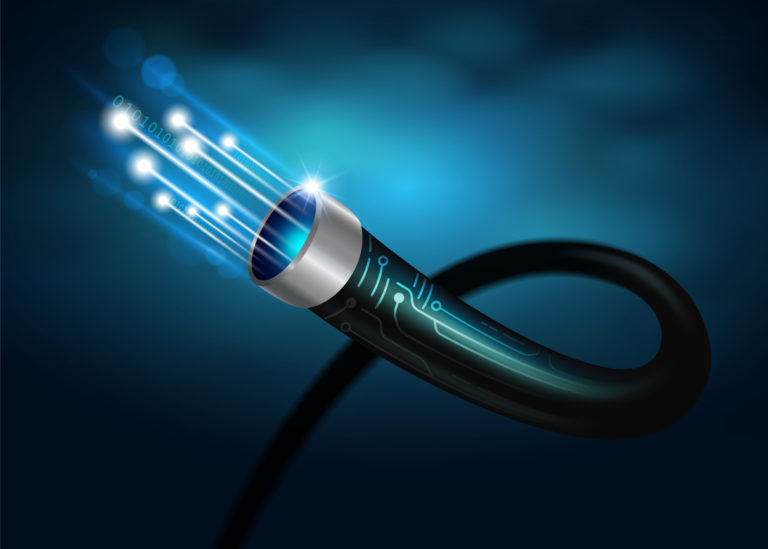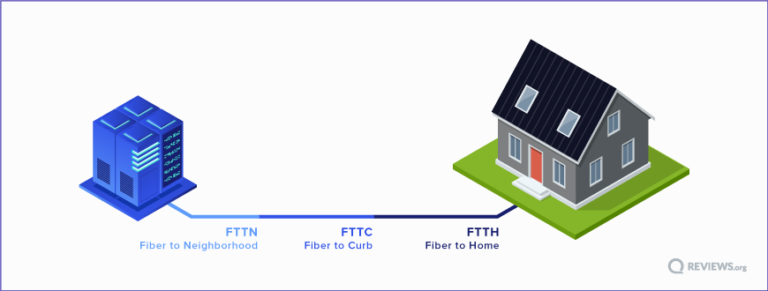Get fiber internet access and download all the things at light speed.
How Does Fiber-Optic Internet Work?
A fiber connection lets you hop online thanks to fiber-optic cables, which use light signals to send data to and from your computer.
Because of the newer technology behind it, fiber internet far surpasses DSL and cable internet in terms of internet connection speed and reliability.
Still curious? Here’s more on how fiber internet works, why it's worth the money—and how to get a fiber connection of your own.
What is fiber-optic internet?
We mentioned before that fiber internet lets you surf the web thanks to fiber-optic cables filled with glass filaments. Those cables send data back and forth thanks to lasers and light signals. (Cue dramatic echo.)

But that may be too simple of a definition for the tech-savvy among us, so let’s dig in a little more.
“Fiber-optic cable carries light very well over relatively long distances with low attenuation and distortion of the light signal,” says Frank Cornett, a retired electrical engineer for Intel.
In terms of your internet connection, attenuation means the strength of the signal sent to your computer gets weaker over time. That change makes the signal harder for your computer to process overall. With fiber, the signal stays stronger so you get faster wireless internet access and better streaming. Zoom.
That light signal uses binary to communicate with your computer. “. . . The presence of light might indicate a binary one and the absence of light would indicate a binary zero,” says Frank. Pretty cool.
By signing up, you agree to our Terms of Use and Privacy Policy.
Differences between fiber, cable, and DSL internet
You might now be wondering why fiber is so much better at transmitting data than cable or DSL internet connections. Well, the answer lies in the types of cables used.
Curious to learn more about cable internet? Check out our guide here.
DSL and cable internet both rely on copper wires to transmit data—the same kind of wires that transmit your voice over a telephone line. That goes to show you just how long this technology has been around.
“In contrast to fiber-optic cable, which carries light with relatively low attenuation and distortion, copper wires significantly attenuate and distort the voltage signals they carry,” Frank explains.
That’s a bad thing, and it gets worse.
Distance is a big problem for cable and DSL
The problem of attenuation and distortion for copper wires gets worse the longer those wires get—so the farther away from your neighborhood node and internet service provider (ISP) you live, the worse your signal could get. Attenuation and distortion also get worse with your internet speed. (That’s why DSL and cable internet can only go so fast.)
That’s why “a link made up of fiber can provide much faster data transfer than copper,” Frank says. That means faster load times, higher-quality streaming, and less mashing of the reload button when your favorite website won’t load fast enough. (Yes, we’re button mashers and we’re proud.)
Your internet speed also depends on how much data the infrastructure can handle.
Like we mentioned, fiber-optic internet lines transfer data using modulated light instead of electricity. That gives them much higher bandwidth capacity, since they’re not bound by the physical limitations of electricity conducting through metal.
Here’s a quick look at how quickly you can download files with fiber internet versus DSL and cable.
Speed/time examples are estimates.
Fiber internet compared to DSL
Fiber internet connections work at speeds up to 1 gigabit per second—literally 100 times faster than those old copper wire connections. Providers like AT&T, Frontier, and Ziply Fiber use this kind of connection.
Traditional copper wires used by DSL and cable internet were originally intended to transmit voice only, though, so they’re limited in the amount of data they can handle.
But both DSL and cable internet speeds got better over the years, so you may not readily see the difference when you compare these types of internet plans.
Some companies only offer one type of connection, but some providers like CenturyLink Internet and Xfinity Internet offer DSL, fiber, and cable options.
Here's a quick look at some fiber, cable, and DSL internet plans to compare.
Different types of fiber internet

There are three types of fiber internet—and not all are made equal.
Fiber to the home or premises (FTTH or FTTP) means your fiber internet connection goes straight into your home. If your home isn’t already set up to receive a fiber connection, you may need your ISP to drill holes or even dig nearby. This is the holy grail of fiber connections.
Fiber to the curb (FTTC) means your fiber connection goes to the nearest pole or utility box—not an actual concrete curb. After that, coaxial cables will send signals from the “curb” to your home. This means your connection is made up of part fiber-optic cables, part copper wires.
Fiber to the node or neighborhood (FTTN) provides a fiber connection to hundreds of customers within a one-mile radius of the node. The remaining connection from the node to your home is often a DSL line that uses existing telephone or cable lines.
For FTTN fiber internet, this is where things get tricky. The farther you live from the node, the longer the DSL line needs to be to reach your house—and the longer the line, the more attenuation and distortion you get, causing slower wireless internet access.
“With FTTN, the DSL link from the node to the home amounts to a bottleneck in the overall link,” says Frank. We don’t know about you, but bottlenecks and internet don’t sound like a match made in heaven.
Who is fiber internet best for?
Is fiber internet right for you? We say yes.
Fiber internet uses a newer technology, and therefore tends to be more reliable and faster. You may not need 1,000 Mbps download speeds, but even if you grab a 100 Mbps fiber internet plan, you'll likely see fewer outages and overall faster speeds than you would with a 100 Mbps cable or DSL plan.
One other thing fiber internet offers that cable and DSL don’t is symmetrical download and upload speeds—meaning your upload fiber speed is the same as your download fiber speed.
So if you pay for a 300 Mbps fiber connection, your upload speed should also be 300 Mbps. (With cable and DSL, upload speeds normally only rev up to an average of 10–15 Mbps.) Faster upload speeds are a huge boon to anyone who deals with large files or jumps into a lot of video calls.
How to get fiber internet
While fiber sounds amazing if you’re a lover of all things internet, the reality is it’s still not widely available.
Right now, fiber is mostly available on the East Coast and in big cities—though there are a few small ISP startups offering fiber elsewhere. ALLO in Nebraska and Colorado and Endeavor Communications in Indiana are two that come to mind—and both scored in the top 10 in our fastest ISPs analysis.
Here's a quick look at some of the larger fiber internet providers in the US:
The best way to find out if these ISPs are worth their salt is to see what real customers have to say and compare performance and pricing. We’ve got all that and more—check out our AT&T Fiber, Verizon Fios Home Internet, Frontier Fiber, and Google Fiber reviews.
If you’re lucky enough to have fiber internet in your area, here’s how the five best fiber ISPs compare.
Also check out the full Metronet review.
See our picks for the best fiber internet providers.
Related Articles



